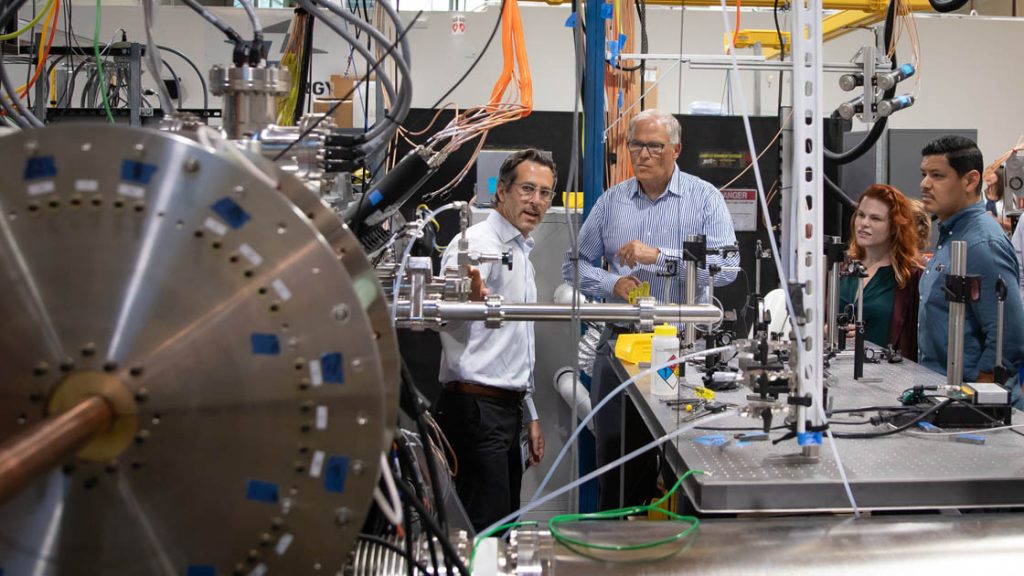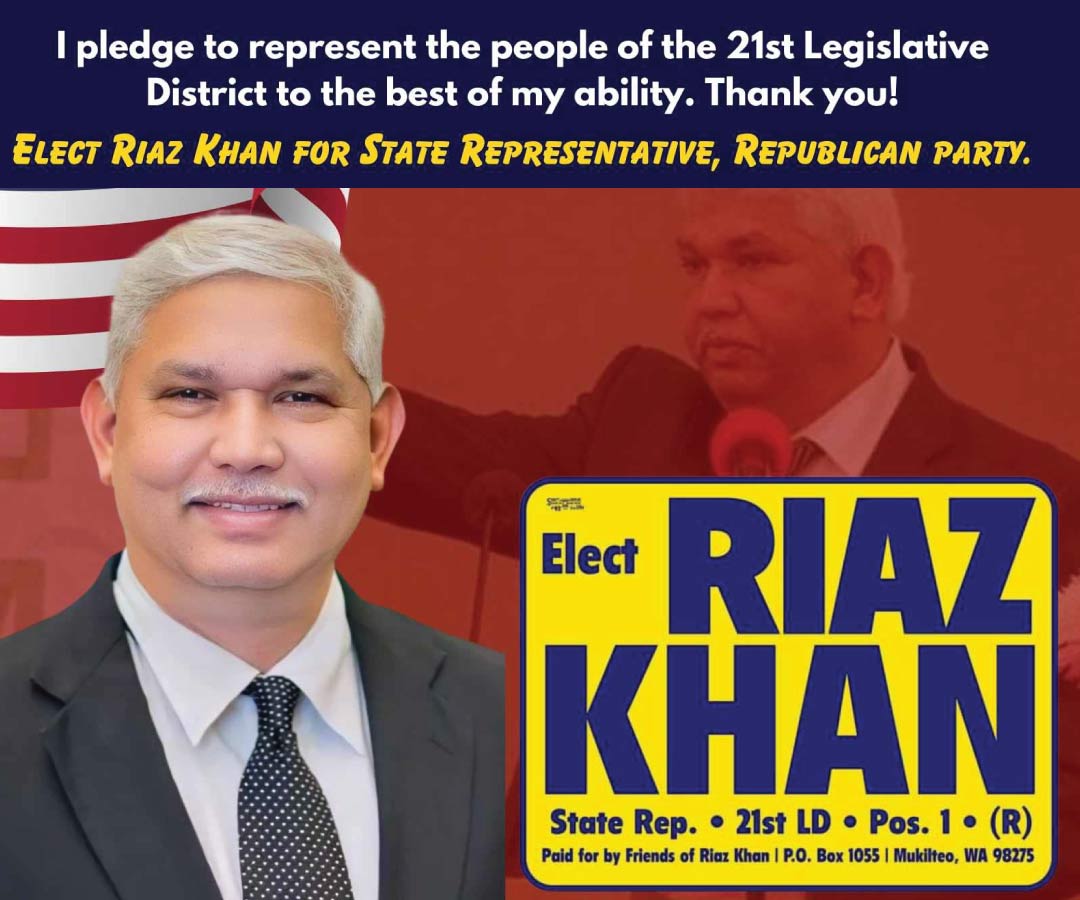EVERETT—Governor Jay Inslee paid back-to-back visits to two key fusion energy startups on Tuesday, July 9—Helion Energy and Zap Energy both located in Everett—to see first firsthand how recently passed Substitute House Bill 1942 will pave the way for how Snohomish County, and the world at large, approaches its clean energy problem.

“When you have something that can change the world, that’s worth taking the risk,” Governor Inslee declared to a room full of reporters at Everett’s Helion Energy, as he stood in front of a part that will be used to build the world’s first-ever machine to demonstrate electricity production from fusion.
SHB-1942, introduced by Clyde Shavers (D-Oak Harbour) and co-sponsored by Cindy Ryu (D-Shoreline), promotes the integration of fusion technology within the state’s clean energy policies. It passed unanimously in both chambers last session and was signed into law on March 28 and went into effect last month.
Inslee’s first stop of the day was Helion Energy, a fusion energy company with nearly 308 employees who is currently in the works to build the world’s first fusion power plant in Chelan County by 2028.
“I am convinced that this is a world-changing technology assuming we can succeed,” said Governor Inslee. “This is a very Washington project because it’s based on ambition and incredible technological talent – that’s what we do here in Washington State. I’m really happy that we are plowing the ground ahead, while [David] is building the machine, we’re building a place to put it and that’s the kind of race that we’re in.”

The problem therein lies with policy, however, specifically when dealing with how to build a safe and sustainable fusion energy plant, a major reason Helion met with the Governor on Tuesday.
In June the United States Senate passed the bipartisan Accelerating Deployment of Versatile, Advanced Nuclear for Clean Energy (ADVANCE) Act as part of the Fire Grants and Safety Act which boosts responsible production of clean nuclear energy globally by developing and deploying new nuclear technologies. That act immortalizes that fusion power is not nuclear power which would free Helion Energy from many federal regulations. The bill now heads to President Joe Biden for signature.
“We still want to do it safely, but we want to be able to do it faster” said Helion Founder and CEO David Kirtley. “We have a very tight timeline and not a lot of sleep. What that means is we need to build as fast as possible and build as fast as possible.”
If the President signs off on this legislation, Helion and other fusion energy companies, would be regulated more like hospitals, since the radiation emitted by fusion energy production is along the same lines as the radiation emitted by hospitals, according to the International Atomic Energy Agency.
Helion was founded in 2013 by David Kirtley, John Slough, Chris Pihl, and George Votroubek, focused on generating zero-carbon electricity from fusion. Its mission is to build the world’s first fusion power plant, enabling a future with unlimited clean electricity.
On May 10, 2023, Helion announced a power purchase agreement with Microsoft, one of the company’s two customers who will purchase electricity from Helion once the plant is operational.
“We are extremely proud to have Microsoft as our first customer! With this partnership, not only are we advancing the timeline to have commercial fusion energy on the grid, but we are also supporting Microsoft’s goal to be carbon negative by 2030. With a long history of unveiling groundbreaking technology while considering their impacts on the climate, Microsoft is the ideal customer for electricity from our first fusion power plant,” said Kirtley after the agreement was signed.
In 2019 Helion Energy completed its sixth prototype, Trenta, which pumps out over 10,000 fusion pulses and achieves temperatures up to 9 kiloelectron volts (a unit used to measure how much energy is gained from an electron).
Now it’s in the works to develop its next state-of-the-art machine, Polaris, which will operate up to 1000 times faster than Trenta and, if successful, will be the world’s first fusion machine to demonstrate electricity production from fusion. The accelerated model will be more apt to meet commercial demand once operational, the company stated.
“The world needs fusion energy and it needs it now,” said CEO David Kirtley during Tuesday’s tour.
Helion’s long term goal is to build future fusion energy machines that are smaller and more efficient to make the energy source ultimately more accessible.
“We need stable base load power that does not pollute. We’re building out all of our renewable energy possible for solar, wind, and everything in efficiency and battery as well. But ultimately to defeat climate change we need some base load power and that’s what [fusion energy] provides,” said Governor Inslee. “When you have something that can change the world you got to go for it.”
Inslee visits Zap Energy
After Inslee’s visit to Helion he made his way to Zap Energy, a startup currently building affordable, compact, scalable fusion energy technology with potentially the shortest path to commercially viable fusion and orders of magnitude less capital than traditional approaches. It does this by confining and compressing plasma without costly and complex magnetic coils.

“It will be exceptionally difficult to decarbonize the planet without something like fusion, but progress in fusion’s development has grinded slowly largely due to the scale and cost of the machines,” said Andy Freeberg, Head of Communications for Zap. “Zap’s distinct physics approach provides the ability to iterate much more quickly on smaller, cheaper devices that have the fastest improving performance in fusion over the past several years. Washington has become an international leader in fusion development and the faster we can prove fusion’s ability to be an on-demand source of power, the easier it will be to deal with many of the biggest obstacles to a clean energy transition.”
Zap Energy’s Fusion Z-pinch Experiment (FuZE) was originally funded for research at the University of Washington by the U.S. Department of Energy’s Advanced Research Projects Agency – Energy (ARPA-E). Unlike magnetic confinement and inertial confinement, Zap Energy’s technology is based on a plasma confinement scheme known as a Z pinch, where large electric currents are channeled through a thin filament of plasma. The conducting plasma generates its own electromagnetic fields, which both heats and compresses it.
Compressing and heating plasma made of two forms of hydrogen called deuterium and tritium causes their nuclei to collide and fuse. When they do, fusion reactions give off roughly 10 million times more energy per ounce than burning the same amount of coal, the company says on its website.
Its most recent FuZE-Q platform is the breakthrough technology now leading to a “cheap, compact, scalable fusion energy technology with potentially the shortest path to commercially viable fusion.” . Last year, the company was awarded $5 million from the U.S. Department of Energy’s Milestone-Based Fusion Development Program.

“We have two of the leading fusion companies just a mile from each other,” Inslee told the Lynnwood Times. “We have adopted some policies to help them. I may not have designed the fusion reactors, but I recognized the technology’s potential and government is helping them.”
Inslee shared that about 500 people are employed between the two companies working on this breakthrough energy source which is needed to meet baseload power demand. He commented how impressed he was that Zap Energy is truly producing a homegrown product.
“They are building their capacitors inhouse, in Washington state,” Inslee said. “It is a very local company with local technology, local manufacturing, and local technicians.”
Inslee foresees fusion as a viable energy source, adding to the state’s diverse energy portfolio.
“Fusion is the Holy Grail of energy with no pollution, no security risk, and almost an infinite supply of fuel,” Inslee said. “This would be such a game changer for the world, not just Washington state.”
Notable attendees included local Everett State Representatives Mary Fosse and Julio Cortes.
The Governor’s final stop in his tour through Snohomish County was at Paine Field’s new Sustainable Aviation Fuel (SAF) Research and Development Center—a global first for sustainable aviation fuel—which researches and develops biofuels for the aerospace industry with the ultimate goal of reducing its carbon footprint.
Each of the three locations Governor Inslee visited Tuesday are doing their part of Washington’s Climate Commitment Act which caps and reduces greenhouse gas emissions from Washington’s largest emitting sources and industries. The ultimate goal of the act, which was passed by law makers back in 2021, is to reduce greenhouse gas emissions by 95% by 2050.
Editor’s Note: Contribution of Zap Energy by Mario Lotmore.
















